Glimpsing the Northern Lights in all their mystical and sky-transforming glory is one of those bucket-list life experiences that many world travelers often wait years to see.
But can you actually see the northern lights on a cruise? The conditions must be just right, but it's highly likely to see this magical and sometimes elusive scientific phenomenon on a Northern Lights cruise sailing the Arctic Circle during the long, dark winter nights.
"Cruising is a nice way to see a lot of places, but in particular the Northern Lights," says Stephanie Goldberg-Glazer, owner of Live Well, Travel Often, a boutique travel agency. "Cruise ships are able to be out at sea where it is dark for optimal viewing," she says, and when in port, they can create opportunities for guests to access optimal viewing sites outside of cities and their lights.
Read on for our comprehensive guide on how to choose the best northern lights cruise for you.
What Is the Best Time To Go On a Northern Lights Cruise?
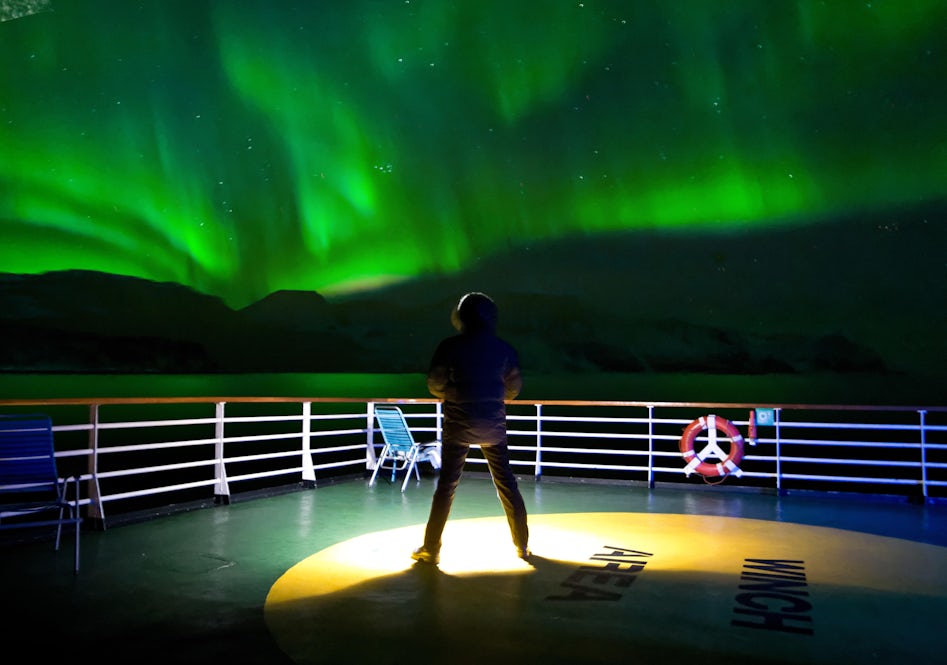
Seeing the northern lights on a cruise isn’t guaranteed (although at least one cruise line, Hurtigruten, does issue a guarantee for certain cruises. See below). But you will increase your odds of seeing the northern lights by being in the right place in the Arctic Circle at the right time.
The arctic viewing season for northern lights cruises is from late September to late March/early April, though the best months are December through March, when there are the longest hours of darkness and many clear night skies. Generally, skies are clearest near the spring and fall equinoxes in later September and March. Some late September/early October Alaska cruises can include northern lights sightings as well.
What Are The Best Cruise Lines That Sail Northern Lights Itineraries?
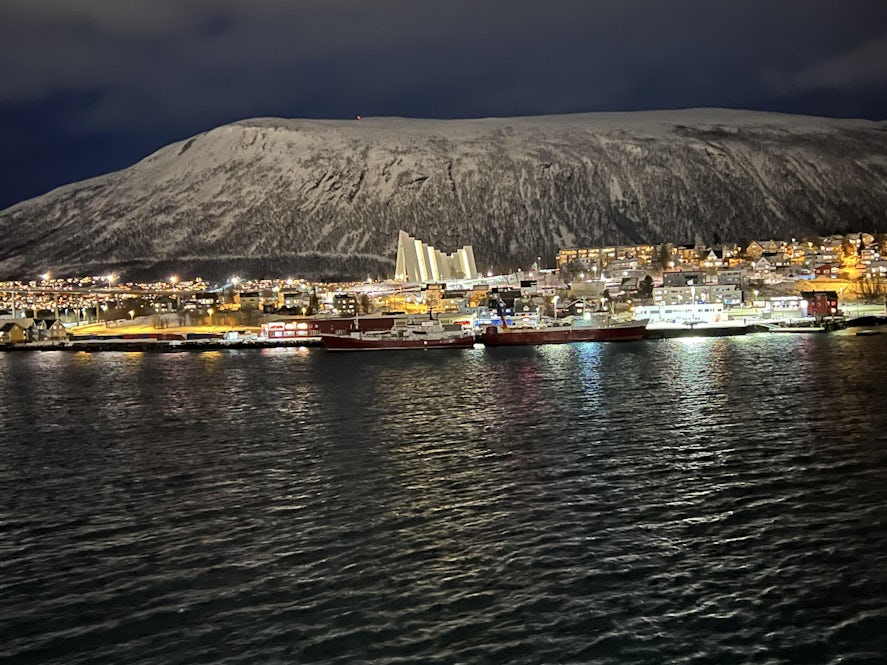
Midsize and small cruise ship companies offer a variety of Arctic Circle sails during prime northern lights viewing months. While this list is not inclusive, lines to choose from include Hurtigruten, Viking, Cunard, Quark, P&O, Silversea, Fred. Olsen Cruise Lines, Saga Cruises, Aurora Expeditions, and others.
"Viking has several winter trips from London to Bergen, and Cunard offers a cruise up coastal Norway in November 2022 searching for the Northern Lights. Hurtigruten sails the coast of Norway, and Quark Expeditions has a fantastic cruise to Iceland and Greenland in September to see the Northern Lights," says Goldberg-Glazer of Live Well, Travel Often.
"The Northern Lights cruises can hardly be considered mainstream, but Cunard and Viking are going to offer the experiences most familiar to those with experience cruising the Caribbean or Mediterranean on a larger ship. Quark is going to offer more unique land-based experiences."
Here are a few examples of 2022 and 2023 itineraries that offer northern lights-themed cruises.
Both Hurtigruten Expeditions and the Hurtigruten’s Norwegian Coastal Express, offer a good number of itineraries that showcase the Northern Lights. The Coastal Express serves as both a passenger cruise line and a lifeline for Norwegian coastal residents and these working ships transport locals’ cars, fjord towns’ freight and up to 1,000 total passengers on any given day. For those absolutely intent on seeing the northern lights, both Hurtigruten Expeditions and its Coastal Express offer a Northern Light Promise on select itineraries, including the Expedition Cruise from the Northern Lights to Dover, The Astronomy Voyage/In Search of the Northern Lights (12 days),The Roundtrip Voyage (12 days), and the Voyage of Discovery (11 days).
Under the Northern Light Promise, if the Northern Lights do not appear on a traveler's applicable Norway Expedition cruise, the expedition group will give travelers another Norway cruise free of charge.
Viking Cruises’ 13-day In Search of Northern Lights itinerary, travels from London (Tillbury), England to Bergen, Norway (and in reverse), with multiple on-board lectures about the myths and science of the northern lights and tips on best photographing them. Passengers can opt-in for overnight wake-up calls, so they can get some sleep without worrying about missing a Northern Lights sighting.
Cunard’s Norway and Northern Lights cruise is a 12-day roundtrip along Norway’s coastline from Southampton, England on Queen Mary 2, or Queen Victoria ships. Guest speakers, astronomers and award-winning photographers are usually on board to join guests on deck to each evening to scan for and enjoy the northern lights show.
Aurora Expeditions’ 22-day Northern Lights Explorer itinerary starts in Kirkenes, a small town in far northeastern Norway, stays close to the coastlines of the Arctic Circle, and skirts around the Norwegian and Greenland seas, and ends in Bergen.
P&O Cruises, part of Carnival Corporation, also offers Northern Lights cruises that travel along the Norwegian coast and, like many of Norwegian-focused northern lights itineraries, forays “deep in the fjords and to the fringes of the Arctic Cricle in search of the aurora borealis.”
Iceland, Greenland, and polar regions around the Northwest Passage promote some of their active, adventurous cruises around the equinoxes in September and March as northern lights viewing opportunities as well. Lines cruising in these regions include Hurtigruten, Silversea, Lindblad Expeditions, Viking Cruises, Quark Expeditions, Adventure Canada, and others.
What Kind of Things Do You Do on a Northern Lights Cruise?
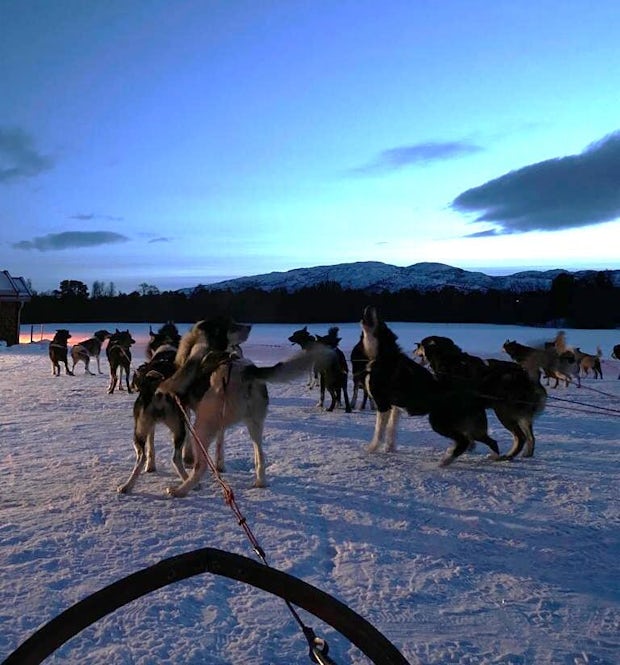
The best northern lights cruises provide plenty of opportunities for passengers to learn about, celebrate and, of course, see the northern lights. But there will also be activities geared to exploring parts of the world filled with many other natural, cultural, and man-made wonders.
Onshore activities for cruisers might range from museum and science center visits to dogsledding with huskies, cross-country skiing, snowmobiling, ice-fishing, and scenic helicopter rides. Some cruises offer guests opportunities to spend a night in a snow-ice hotel and visit wildlife sanctuaries where wolves, wolverines, musk oxen, elk, reindeer, and other Arctic mammals might be spotted. And in some ports, cruise guests may learn about and visit with some of Norway’s indigenous Sámi people who, under Norwegian law, are generally the only people in Norway who may own and herd reindeer.
On northern lights-themed cruises, viewing activities and excursions will abound. Announcements (even opt-in late night wake-up calls) may be issued when there’s an opportunity to view the northern lights from your ship. Excursions may give you the opportunity to be transported to northern lights viewing spots by everything from buses and minivans to small boats and dogsleds.
On board and in the field, you’ll get tips on how to best photograph the northern lights so you can document your experience (and show off to your friends). And there will be lectures that explain the science of the aurora borealis and the myths and cultural beliefs that a variety of cultures associate with the appearance of the northern lights.
What Countries Do You Visit On a Northern Lights Cruise?
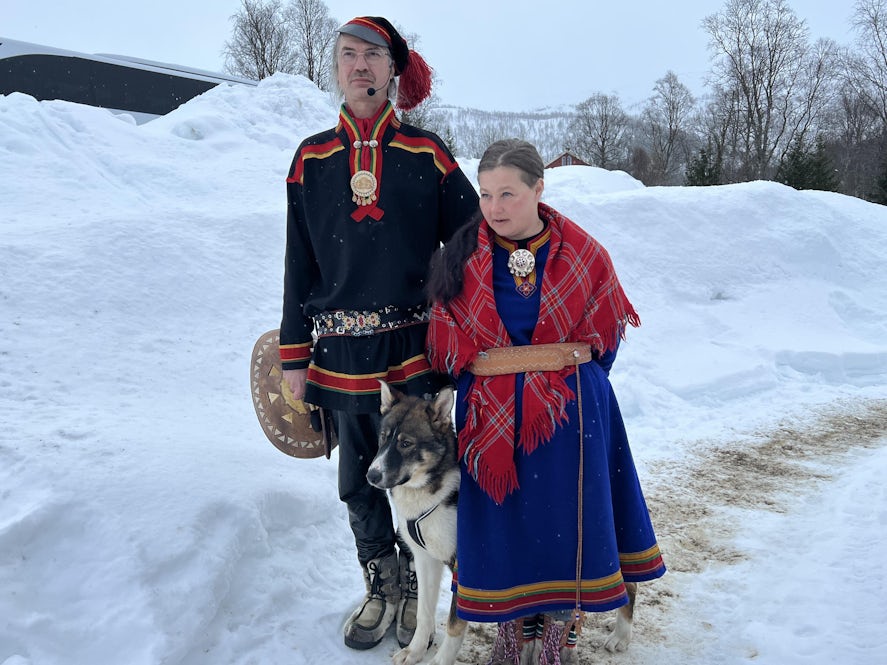
Northern lights cruises depart mostly from ports in the U.K. and Norway and generally sail 10 to 15-night itineraries during the winter season. Many cruises hug the northern Norwegian coast above the Arctic Circle. Some venture to the Svalbard Archipelago, where the Gulf Stream flows prevent the seas from freezing in winter.
Norway: Norway dominates the northern lights cruise circuit with voyages ranging from five to 14 nights. When selecting a northern lights cruise, keep in mind that sailing along Norway’s three northernmost counties – Nordland, Troms, and Finnmark – offer the greatest opportunities for viewing the northern lights, both onboard the ship and during nighttime excursions ashore. Ports of call often include Bodo, Tromso, Alta, Honningsvag, Kirkenes. Some cruises stop in Norway’s Vesteralen, Lofoten, and Svalbard islands.
Iceland, Greenland, and Northwest Passage: Cruises to these destinations average 14 nights but can be a short as three nights when part of Arctic land tours or up to a month on icebreaking expedition trips. Cruises often stop in Reykjavik, Iceland, and Greenland’s capital city, Nuk, as well as historic Sisimiut and Ilulissat.
Northwest passage cruises travel north around the Canadian High Arctic with stops that might include bird sanctuary Prince Leopold Island, Beechey Island, Canada’s most northern community Grise Fiord and Greenland’s east coast Inuit settlement, Ittoqqortoormiit on the world’s largest fjord system, Scoresbysund **(**Scoresby Sound). It’s located near the remote Greenland National Park, the world’s largest national park, where polar bears, walruses, reindeer, musk oxen and birdlife thrive.
Alaska: Although Alaska enjoys a high volume of aurora activity, few Alaska cruises are marketed as northern lights cruises because the core Alaska cruise season is during the summer, when it is rarely dark enough for the lights to be visible. The chances to see the Northern Lights on an Alaskan cruise increase, however, on early May, late September/early October cruises.
What Ports Do You Visit on a Northern Lights Cruise?
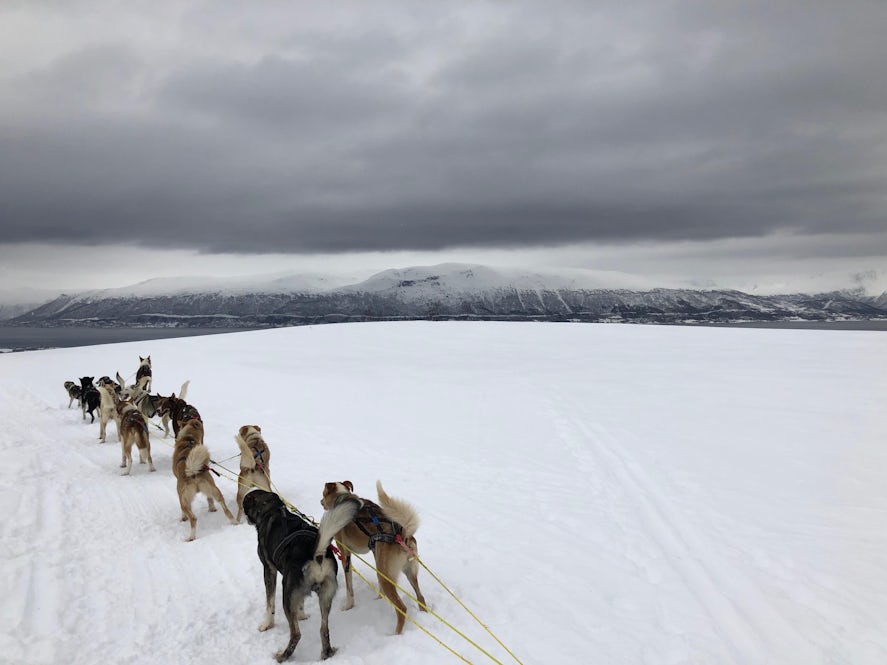
Beyond the rewards of seeing the northern lights, the bonuses of winter season Northern Lights cruises are the stunning contrasts of scenery and the variety of onshore activities. Ports vary greatly from industrial centers and fjord villages to picturesque coastal towns and remote outposts on barren, frozen coasts.
Bodo, Norway: Industrial grit, raw nature, and public art frame Bodo, which is wedged between fjord islands and craggy mountain peaks. At the Nordlandmuseet (Nordland Museum), exhibits survey Norway’s history, fishing industry, Viking and Sami people’s cultures, and rediscovered silver treasure. Norsk Luftfartsmuseum (Norwegian Aviation Museum) showcases Norway’s aviation military history. And giant murals of trolls and stylized summer landscapes splash across sturdy cement buildings housing cafes, antique shops, and art galleries.
Norway’s Vesteralen and Lofoten Islands: These mountainous islands harbor archeological sites of Stone Age farmers and Viking colonies, as well as small farms and fishing villages, such as postcard perfect Stamsund. Winter northern lights cruises call on major commercial port Sortland, which is often referred to as the Blue City because so many buildings in town have been painted blue. A Loftoten excursion might include a trip to the tiny hamlet of Borg, which is home to the Lofotr Vikingmuseet (Lofotr Viking Museum), which features archeological exhibits and a reconstruction of the world’s biggest Viking Age longhouse, which was once home to a powerful chieftain.
Tromso, Norway: Considered the gateway to the Arctic from whence many historical explorations launched, Tromso’s museums and architecture do a great job of preserving Norway’s adventurous polar past. Port attractions include the city center’s preserved mid-19th-century wooden buildings and the contemporary stained glass and triangular-shaped Tromsdalen Church, nicknamed Ishavskatedralen (The Arctic Cathedral), an impressive church and concert venue. Polaria is an Arctic research center and aquarium housed in a stainless steel, saw tooth structure that looks like giant, stacked glacial ice shared. Inside an 1837 wharf Custom House, the Polarmuseet (Polar Museum) exhibits recount the region’s hunting history and tell the stories of famous icy expeditions by explorer Roald Amundsen and sea captain Fridtjof Nansen of the North Pole ship Fram. Trom is also the base for active shore adventures, including husky dog sledding and snowmobiling. Tromso is also known for having the most pubs per capita in Norway.
Spitsbergen, Svalbard Archipelago: Some cruises call at Longyearbyen on Spitsbergen, the southernmost of Norway’s Arctic Ocean island of Svalbard. Covered mostly by glaciers where polar bears roam, adventurous cruisers hike and dog sled accompanied by guides toting rifles.
Alta, Norway: A historic Sami settlement and site of the world’s first northern lights observatory, industrial Alta was rebuilt after World War II. Winter cruisers visit the Northern Lights Cathedral, which houses an exhibit about the myths and science of the northern lights and can overnight at Sorrisniva Igloo Hotel. Outside of town, at Hjemmeluft, the UNESCO World Heritage Site encompasses the Alta Museum-World Heritage Rock Art Centre. In winter, visitors tour museums exhibit about the region’s history and geography, Sami culture, and the ancient rock art discovered there. Outdoor walkways (open when snow-free) offer access to Northern Europe’s largest collection of petroglyphs and rock paintings created by hunters-fishers 2,000 to 7,000 years ago.
Honningsvag, Norway: Here, cruises board buses to tour Island fishing villages or go to the Nordkapp or North Cape – Europe’s northernmost point, easily accessible to tourists and marked by a globe sculpture on a clifftop above the pounding Arctic Ocean. Nordkapp’s visitor center houses a large gift shop, some wildlife, historic diorama exhibit, and a cinema showing a dynamic northern lights film infused with Sami myth and scientific perspectives.
Kirkenes, Norway: Kirkenes is Norway’s northernmost urban center, and is rich in Sami culture, iron ore and World War II history. Excursions might include a military history-focused bus tour to the dense, pine forested Norway-Russia border and an underground bunker visit. Cruisers might also enjoy frozen fjord-caught Kind Crab dinner, Sami cultural visits, snow mobile rides and overnights at the Snowhotel.
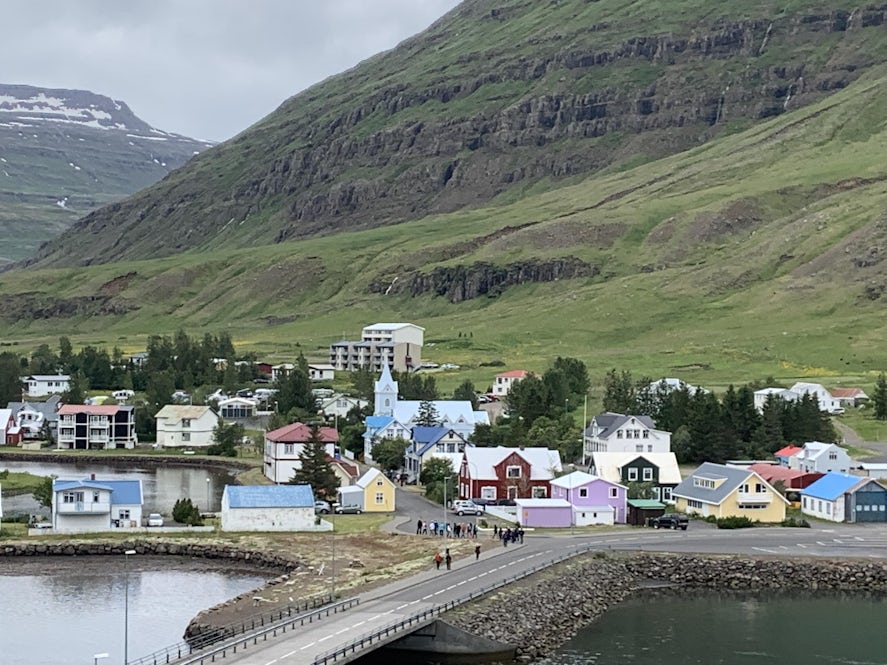
Reykjavik, Iceland: The island country’s capital and southern cove cruise port is in Reykjavik, a city with lots of nightlife, an impressive opera house, and easy access to the famed geothermal Blue Lagoon. A popular day trip is to UNESCO World Heritage List site Thingvellir National Park, which is where the American and Eurasian tectonic plates meet, and where Iceland’s parliament was founded in 930 A.D. Visitors also head to Gullfoss to marvel at a two-tiered waterfall plunging into a deep, narrow canyon. Nearby, it’s possible to see spouting geysers at Haukadalur Valley. The famous Ring Road connects Iceland many waterfalls, national parks, wildlife refuges, and glacial areas and is a popular pre or post cruise day trip.
Nuuk and Ilulissat, Greenland: In Nuuk, Greenland’s capital, visitors take in the Katuaq Cultural Center, Gronlands Nationalmuseum (Greenland National Museum and Archives), Nuuk Art Museum, historical Old Harbor, and the country’s oldest and largest microbrewery, Godthaab Bryghus. Vessels call on Sismiut, which is grounded in strong Saqqaq, Dorset, and Thule cultural history. Passengers on ships sailing Greenland’s west coast around Disko Bay might spot Bowhead, Narwhal, and Beluga whales. At Ilulissat, (birthplace of Northwest Passage explorer Knud Rasmussen), there’s Ilulissat Icefjord and the massive jagged-iced Jakovbshavn Glacier. This UNESCO World Heritage Site is one of the world’s most active glaciers.
Northwest Passage: This famous route, traveled mostly in summer months from northern Canada through parts of Alaska and to Russia’s far east and Anadyr, is open for limited colder-months cruising, most often on icebreaker expedition ships. Sites visited might include Radstock Bay’s polar bear research area; the Yukon’s Ivvavik National Park; and Beechey, Prince Leopold, Banks (Aulavik National Park), Herschel and Wrangel Islands.
What Do You Need to Know Before Booking a Northern Lights Cruise?
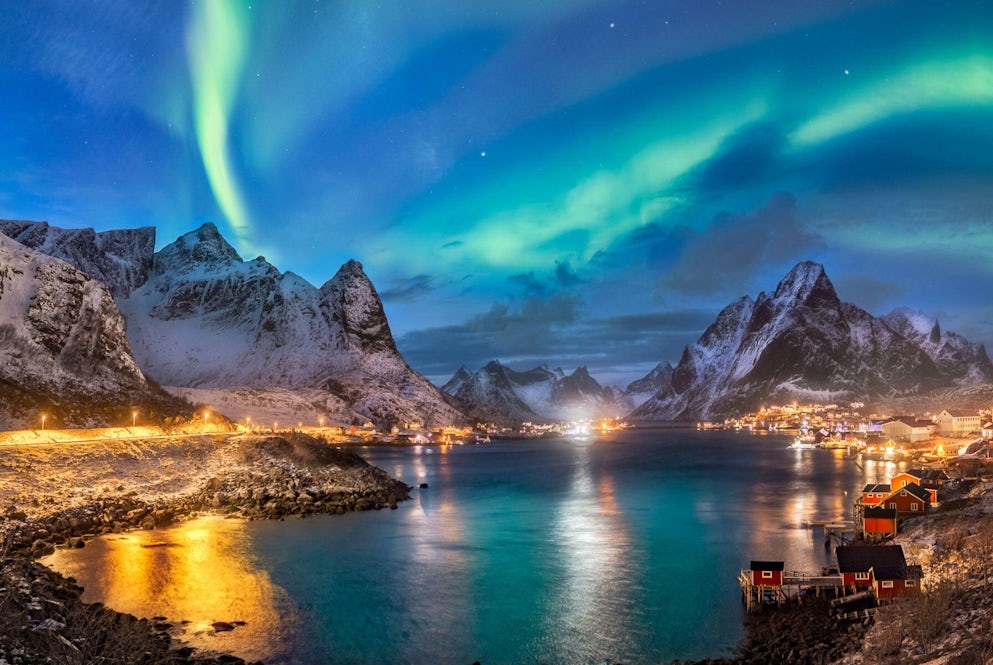
Be flexible: The northern lights are a natural phenomenon that performs on its own schedule. So, there are no guarantees you’ll see them on a cruise that has Northern Lights in its name, regardless of when you sail. NASA’s Space Weather Bureau website (www.spaceweather.com) and a variety of Northern Lights apps can help remove some guesswork by tracking solar storm activity and alerting you to when the northern lights might be visible from your location.
On many cruises, when passengers or crew spot northern lights, they make ship-wide announcements. Because the northern lights often appear late at night or very early in the morning, some ships offer opt-in wake up calls for this purpose.
Bridgett Quinn Weber, an advisor with Cruise Specialists who works with expedition cruises offered the advice below.
When the northern lights do appear, "more than likely the ship will turn off most of the exterior lights," Weber says. "But you can prepare as soon as you board the ship by scouting out the darkest spot outside, and up top on the ship." That may be away from the ship stairways and public rooms.
Come prepared. Scanning night skies for northern lights requires patience and warm clothing. So be sure to pack both. Besides a down coat, warm hat, and gloves, be sure to pack wind and waterproof pants (i.e., ski pants or rain pans), thermal long underwear, wool socks, and winter boots for walking on snow and ice. Ice crampons may come in handy, especially in ports where walkways may be icy or slick. On some active excursions, outfitters provide weather-appropriate gear, but you can’t always count on that. And don’t forget your bathing suit for outdoor tub soaks and pool swims onboard.
Photographing the northern lights: A tripod or monopod are necessary and will be your tools for shooting exposures of around 30 seconds or more, which is what is required to capture the northern lights’ colors. Bring photo memory cards and an extra charged camera battery because the cold quickly drains them. Gloves with flip-back mitten covers for your fingers will make it easier to stay warm and press your camera – or smartphone’s – shutter release button. You can get great photos of the northern lights, but the best advice we’ve heard is that when the lights do appear, don’t spend all your time trying to get the best picture.
"There are lot of incredible photos of the northern lights out there taken by great photographers," one expert told us. His advice: "Take some pictures, then put your phone or camera away and just enjoy the nature’s wonderful show."
